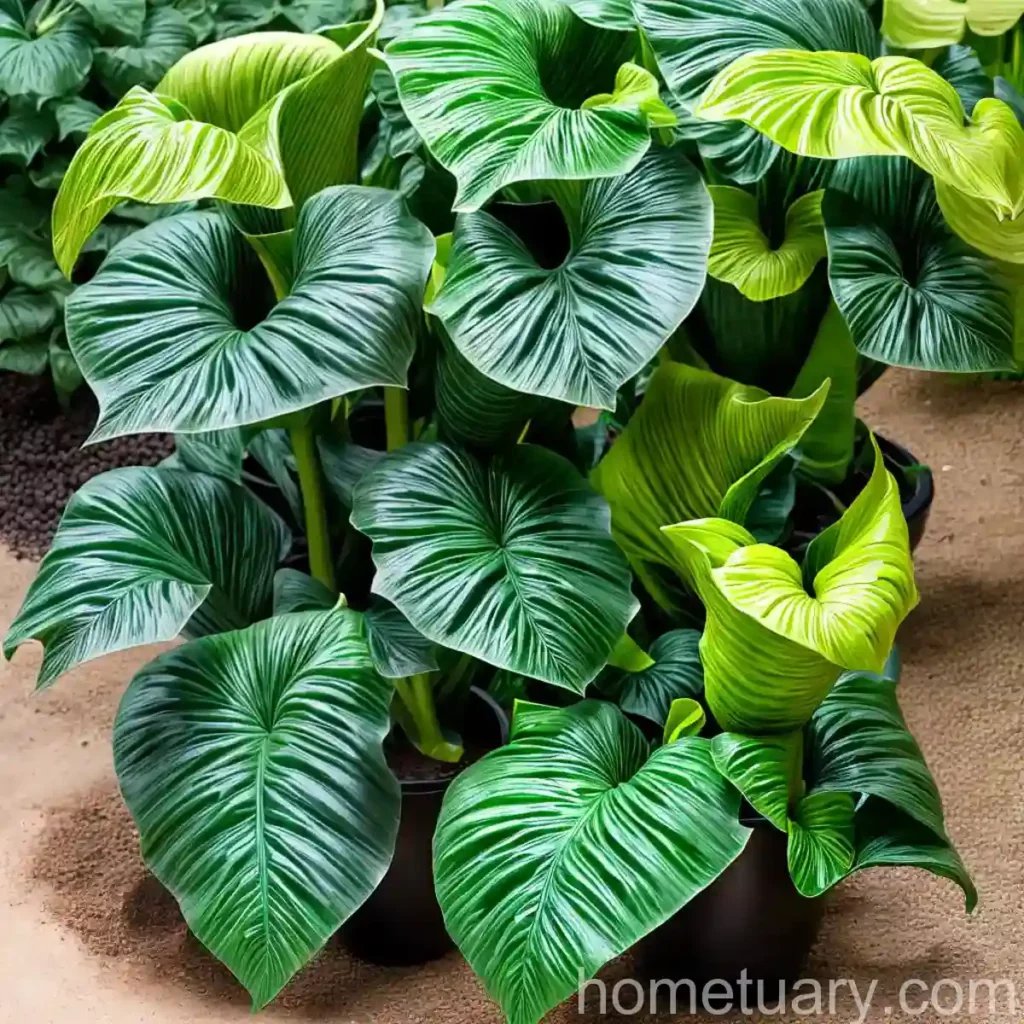Taro (Colocasia esculenta ‘Kona Coffee’): A Comprehensive Guide
Taro, scientifically referred to as Colocasia esculenta ‘Kona Coffee’, is a root vegetable and a staple food in many regions, particularly in the Pacific Islands and Asia. This plant is highly valued for its edible corms and leaves, and it holds significant cultural and traditional importance in various communities. In this guide, we will explore the characteristics, cultivation practices, and uses of taro, particularly focusing on the ‘Kona Coffee’ variety. Additionally, we will delve into its propagation, maintenance, common diseases, and other crucial aspects to help you understand this fascinating plant.
What is Taro (Colocasia esculenta ‘Kona Coffee’)?
Taro, scientifically known as Colocasia esculenta, is a herbaceous perennial plant belonging to the family Araceae. It is native to Southeast Asia and Southern India and has been cultivated for thousands of years for its starchy corms and nutritious leaves. The ‘Kona Coffee’ variety of taro is a unique type known for its distinctive coloration and specific growth characteristics.
Key Takeaways – Taro (Colocasia esculenta ‘Kona Coffee’)
Culture
Taro has a rich cultural significance in many societies, particularly in the Pacific Islands and parts of Asia. It is deeply ingrained in traditional cuisines and is often featured in rituals and ceremonies. The plant’s cultural symbolism varies across different regions, with some communities associating it with prosperity, fertility, and ancestral connections.
Uses
Taro is a versatile plant with various uses. Its corms can be cooked and consumed directly or processed into flour, while the leaves are used in cooking and as wrapping material for food. Additionally, taro holds medicinal value and is utilized in traditional herbal treatments for various ailments.
Water
Taro plants thrive in consistently moist soil and require adequate water to support their growth. It is essential to ensure that the soil remains damp but not waterlogged to prevent rot and other moisture-related issues.
Sunlight
Taro plants prefer partial shade or filtered sunlight. While they can tolerate some direct sun, excessive exposure to intense sunlight can lead to leaf scorching and reduced growth.
Fertilizer
A balanced fertilizer with a slightly higher ratio of phosphorus can support the healthy development of taro plants. Regular fertilization is especially important during the growing season to bolster corm production and foliage growth.
Soil
Well-draining, fertile soil is crucial for taro cultivation. The ideal soil pH for taro ranges from 5.5 to 6.5, and the soil should be rich in organic matter to promote robust growth.
Pruning
Pruning dead or damaged leaves and thinning out overcrowded foliage can help improve air circulation and reduce the risk of disease in taro plants.
Propagation
Taro can be propagated through corms or by planting the top portion of the corm with the growing point intact. The plant can also be propagated through division during the dormant season.
Container Popularity
Taro is a popular choice for container gardening, especially in regions with limited space or unsuitable soil conditions. Growing taro in containers allows for greater control over its environment and can be an attractive addition to patios and indoor spaces.
Common Diseases
Taro plants are susceptible to various diseases, including leaf blight, root rot, and corm rot. Proper sanitation, good cultural practices, and disease-resistant varieties can help mitigate disease issues.
Disease Diagnosis
Early detection and accurate diagnosis of taro diseases are essential for implementing effective control measures and preventing widespread damage to the plant. Consult with local agricultural extension services or plant pathology experts for accurate diagnosis and treatment recommendations.
Common Pests
Pests such as aphids, thrips, and taro caterpillars can pose a threat to taro plants. Regular monitoring and prompt intervention can help manage pest infestations and minimize damage.
Botanist’s Tips
Consulting with botanists and horticulturists can provide valuable insights into the specific requirements and potential challenges associated with growing ‘Kona Coffee’ taro. Their expertise can help optimize cultivation practices and enhance plant performance.
Fun Facts
- Taro leaves are often used as natural umbrellas or sunshades in some cultures.
- Taro is one of the oldest cultivated plants, with evidence of its domestication dating back thousands of years.
Links to External Resources
For further information on taro cultivation, recipes, and cultural significance, explore the resources provided below:
Conclusion
Taro, specifically the ‘Kona Coffee’ variety, offers a fascinating journey into the world of tropical root vegetables and their cultural, culinary, and horticultural significance. By understanding the unique characteristics, growth requirements, and utilization of taro, enthusiasts and cultivators can appreciate the plant’s diverse attributes and contribute to its preservation and continued cultivation. Whether it is grown for its culinary value, ornamental appeal, or cultural symbolism, taro remains a plant of immense importance and intrigue across the globe.
Remember to share your favorite taro recipes and cultivation experiences with fellow enthusiasts, and continue exploring the wonders of taro in your gardening and culinary endeavors. Happy taro gardening!
References
- Mekbib, F.S. et al. (2018). Growth, Yield and Nutrient Uptake of Taro (Colocasia esculenta (L.) Schott) Response to Phosphorus and Variety at Wolaita Zone, Southern Ethiopia. World Scientific Research.
- Hillocks, R.J. et al. (2015). Taro biodiversity and food security. Biodiversity International.
- Waterhouse, L. (2019). Guide to Tropical Root Crops: Production, Uses, and Research in Agriculture. CABI Publishing.















